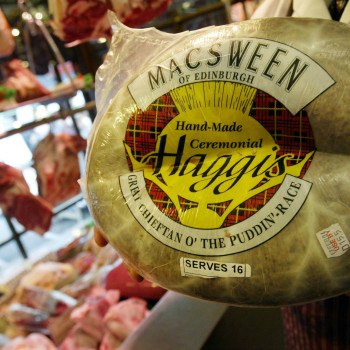Rico Gagliano: What is haggis?
Silvia Delgado: It is traditionally made from sheep heart, liver, and lungs, which is ground. It’s combined with onions, oatmeal, and some spices, and then it’s stuffed inside the lining of a sheep’s stomach and then boiled.
Rico Gagliano: Now, I don’t wanna be culturally insensitive, and we have a lot of listeners, actually, in the United Kingdom, but, to the American palate, I just have to say, it doesn’t sound like a party in my mouth. First of all, where did this come from, this recipe, how did it develop?
Silvia Delgado: Well, much like many central European foods and foods that have a long-standing history, it came sheerly out of necessity. During some of the famines that happened in Europe in the 1700s, there was a necessity to feed large groups of people with very limited cooking equipment and very limited food. There are several versions of history. One says that it was hunters who would allow the people who were butchering their meat to take home the innards, kind of their keep for the work for the day.
Rico Gagliano: And of course, they didn’t get the main cuts.
Silvia Delgado: Right, exactly. They’re not taking home the butts or the flanks or that, they’re taking home the lungs and the livers, and things of that nature, and sheep being the most readily-available game in Scotland, it made a lot of sense to make this dish out of it.
Rico Gagliano: So, in a way, it’s kind of a peasant dish. How did it become kind of a national dish eaten by all classes in Scotland?
Silvia Delgado: Robert Burns was the national poet of Scotland, and he gives tribute to the dish. He refers to it as the chief of all pudding in the beginning of his poem. Pudding, obviously, is a European word that refers to many different types of food, specifically shared foods, so by calling it the chief of all puddings, it kind of staked its claim.
Rico Gagliano: It made it respectable. And you actually celebrate that poem every year here by serving haggis.
Silvia Delgado: His birthday is actually January 25th. We commemorate that where we perform his poem for the audience, so it’s a dinner show event and, of course, we serve that traditional haggis. Although ours is not made from sheep, it’s about as close as you can get here in the United States, given the ban.
Rico Gagliano: Now, you bring that up, that there is a ban. Why, specifically, is it banned? I understand it has something to do with the sheep lung?
Silvia Delgado: Correct. In 1989, I believe, there was a ban put in place by the United States government against sheep lung, due to an outbreak of Mad Cow Disease. Due to that fact, we’re not using sheep, we’re using cow. We take cow liver, heart, lung, dice it up, mix it, and stuff it inside of a cow lining.
Rico Gagliano: Now, that’s the version that you cook for Burns’ birthday, but the version that you have daily on the menu is different, correct?
Silvia Delgado: Yeah. What we’ve done is we’ve taken about 90% ground beef with about 10% liver, so that you still get that little bit of a twinge from the iron flavor, and it’s still kind of the nostalgic flavor profile that you would get from a traditional haggis.
Rico Gagliano: A little gamey.
Silvia Delgado: And then, instead of stuffing it inside of a stomach lining, we’ve actually turned it into almost like a hand pie. We make a very flaky handmade pie crust here in-house, stuff it, bake it off.
Rico Gagliano: But it’s gotta, I mean, I can hear right now Scottish folk listening to this and being like, you put it in a pie? A pie is not a stomach.
Silvia Delgado: It’s not. But, again, palates kind of change as well. I don’t know that many of the Scots that come in here would be able to put down a bowl of a traditional haggis, to be perfectly honest with you.
Rico Gagliano: Really? Do you find when you do the more traditional haggis on Burns night, though, my understanding is that you have an insane amount of people coming in.
Silvia Delgado: We do. We have an insane amount of people because this is the one time that you can try this dish. I don’t know of anywhere else in California where you can have a real haggis. So, for people, like I said, who wanna pay tribute to their country, to their history, and all of that, they come in and do it.
Rico Gagliano: It’s out of duty?
Silvia Delgado: Yeah, I think part of it is out of duty. I would say half of the people that come in truly enjoy the dish as it is prepared traditionally, but those are the same people who, when we found out we were putting a modernized version of a haggis on our menu, now come in and ask for it, and are very excited about it.
Rico Gagliano: All right. Can I try this thing?
Silvia Delgado: Definitely. Let me go grab one for you.
Rico Gagliano: All right. Oh, man, it smells delicious. And it comes with the knife buried in the thing. Is there a reason for that?
Silvia Delgado: Yes. So, normally, when you serve a haggis, it’s a big, round, sausage-looking entity, and you take a knife and you cut right across the top and open it up. In the poem, Robert Burns talks about the slaying of the haggis, and they literally stab it with a knife and slay the haggis.
Rico Gagliano: He meant it metaphorically, I guess, ’cause you’ve got basically a big belly that you’re slicing open.
Silvia Delgado: Exactly.
Rico Gagliano: All right. I’m gonna take a bite out of this thing. I took the knife out. Here we go. Mmm, it’s really delicious and buttery. The inside is almost like a pate.
Silvia Delgado: Essentially, that’s what it is. You’re grinding all of these meats together, so it takes on the consistency of almost like a sausage, or a pate, per se.
Rico Gagliano: Yeah, I really like it. Do you sell a lot of these things?
Silvia Delgado: Ten or fifteen a night as an appetizer, and we sell them for lunch as well. Let me tell you, nothing like that with a good glass of Guinness or another nice, strong beer. Makes a great lunch.


